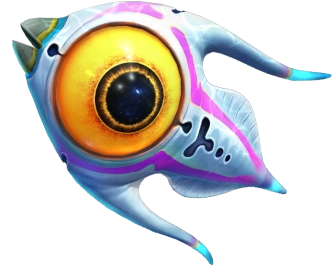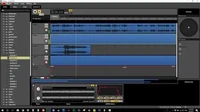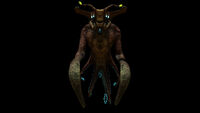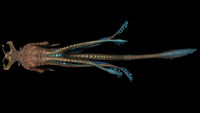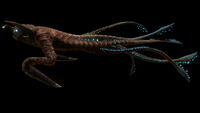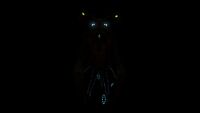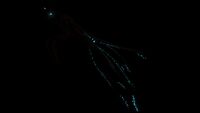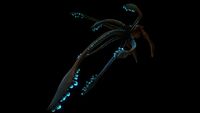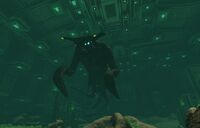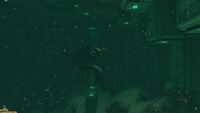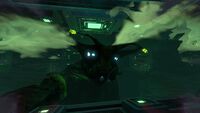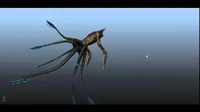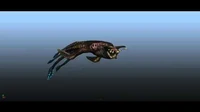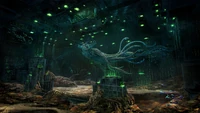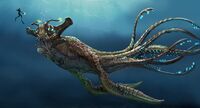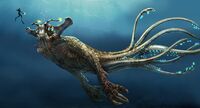
|
Read at own risk This article contains unmarked spoilers. Players new to the game would want to avoid or be cautious toward this article. |
Template:Class 2 Fauna
The closest translation of the alien symbol for this specimen is 'sea emperor'. Bone samples from deceased leviathan specimens indicate some potential for carar immunity. Single specimen captured for study at purpose-built emperor containment facility, constructed in volcanic region at depth 1200m.
― PDA, Data Downloads
The Sea Emperor Leviathan is the largest living species of fauna known in Subnautica.
Appearance
The Sea Emperor Leviathan is colossal in size, having a stocky, entirely armored body and is predominantly pale brown in color, with a few shades of green. Its tentacles are adorned with bright cyan bioluminescent "bulbs".
The creature's head is comparatively small, and quite peculiar in shape (see "Trivia" below for more), featuring two striped antennae with glowing green lures atop its snout, two large mandibles on each side of its rather small mouth, and a glowing hollow in-between these mandibles. It has four binocular eyes, glowing cyan in color.
The Sea Emperor Leviathan's posterior consists of seven long, yet slim tentacles ending with large tentacular clubs, with the largest being in the center, surrounded by the six smaller tentacles.
Unlike the Sea Dragon Leviathan, the Sea Emperor Leviathan doesn't have true graspers; Instead, its forelimbs are two massive, paddle-like arms.
Behavior
Despite its gargantuan size, the Sea Emperor Leviathan's diet consists solely of micro-organisms filtered from the water.
It is suggested that in the past these creatures would have traveled in small herds, occasionally coming to the surface to feast on the microorganisms in the shallower water. When the Carar bacterium was released onto the planet, billions of creatures died, destroying the food source of the species.
The Sea Emperor Leviathan is capable of telepathic speech, which it uses to communicate with the player at various locations around the world. Whenever it communicates with the player, the screen becomes distorted in a similar way to when a Warper teleports the player, or the player enters an Alien Warp Gate.
The Sea Emperor Leviathan will first contact the player telepathically twenty minutes after they have attempted to deactivate the Quarantine Enforcement Platform. It will immediately contact the player again when they have obtained the Blue Artifact, and again upon approaching the Primary Containment Facility. It will continue to interact with the player upon entering the Aquarium, telling them what they need to do in order to hatch the eggs. After the player inserts an Ion Crystal into the Incubator Device, the Sea Emperor Leviathan will speak to the player, and will move to the left side of the Alien Warp Gate, and blow away the sand, uncovering the Warp Gate that the player can use to access the Warp Gate outside of the Quarantine Enforcement Platform.
Upon entering the aquarium, the Sea Emperor Leviathan will climb up to observe and speak to the player, then descend back down. It will also watch the player intently if they are near the Incubator Device or the aquarium Warp Gate, quickly spinning around and coming to a rest on the aquarium's floor.
Story
The captive Sea Emperor Leviathan is the last remaining adult of its species, and a parent to at least nine eggs. The five eggs still remaining must be hatched at some point in the story. The creature is approximately one thousand six hundred years old, and is suggested to have far surpassed its natural lifespan.
Almost all of the Sea Emperor Leviathans died when Carar was released as it killed off their food source, leaving the one captive adult and the eggs it was discovered with. As the only source of Enzyme 42 on Planet 4546B, the Sea Emperor Leviathan and its children are the key to curing Carar.
The last surviving Sea Emperor Leviathan was studied by the Precursors in hopes of finding a cure using its natural production of Enzyme 42. However, due to its weakness, possibly old age or illness, studies conducted showed that it was not a viable source of Enzyme 42 as the enyzmes it produced were too unstable and only reverted symptoms temporarily. After the Precursors could not find a way to hatch its eggs naturally, they took three into the dissection room of the Primary Containment Facility and experimented on them, cutting all of them open and removing the fetus from one of the eggs. One other egg was taken to the egg lab, where it was also tested on. Still they could find no way to cause the hatching process to trigger naturally, and juveniles born outside of the natural conditions could not produce suitable enzymes. They resorted to attaching the eggs to an Incubator Device to keep the eggs alive whilst they worked on more ways to hatch them. Shortly after this, the Disease Research Facility was destroyed, releasing Carar, causing all warp gates to the facility to be closed and initiating the planetary quarantine.
How the prison looked originally is unknown, but it differed significantly to how it looks today. At an unspecified time, the Sea Emperor Leviathan managed to train Peepers to use the Alien Pipe System to distribute Enzyme 42 to the surface. Under the Sea Emperor Leviathan's control, Peepers traveled through the Alien Pipe System, bringing flora seeds to the aquarium, and leaving with small amounts of Enzyme 42 which they distribute at the surface. This system allowed a small amount of life to survive on the planet.
After its eggs are hatched, the captive Sea Emperor Leviathan will play with its children, and then direct them to the warp gate leading to the Warp Gate nearby the Quarantine Enforcement Platform which they will leave through. The captive will begin dying shortly afterwards, as it has used the last of its strength to play with its babies.[1]
Telepathic Contact Dialogue
|
♫###5000 |
|
♫###5000 |
|
♫###5000 |
Aquarium Telepathic Contact Dialogue
|
Are you here... to play?###1000 |
|
My young want to hatch. To play outside this place. We have been here so long.###5000 |
|
You gave me what I asked for. I give you what you seek.###3000 |
|
My young are swimming for the shallows. I thank you. Their freedom is my end.###4000 |
Data Bank Entries
|
SPECIMEN SIZE CATEGORIES HAVE BEEN ADJUSTED UPWARD TO ACCOMMODATE THIS SPECIES 1. (Feeding & Digestion) Despite its size this species subsists entirely on microorganisms it filters from the water. The mere presence of these microorganisms in such a restrictive environment is highly unlikely, depending as they do on a complicated ecosystem of plant and animal life. 2. (Reproduction) Since just one adult specimen of this kind has been identified, it may reproduce asexually, but it may equally be the last of its kind. Large ovary-like organs are carried in the middle section, suggesting that like other species on this planet it produces eggs, however internal scar tissue indicates probable infertility. 3. (Stomach Enzyme) The emperor is the only known source of a unique, complex enzyme which seems to play a pivotal role in protecting the ecosystem against the impacts of the bacterium. Peepers appear to have adapted to distribute the enzyme, however, its structure is unstable, and they require a constant supply to stave off uncontrollable genetic mutation. 4. (Health) Comparative analysis of size and metabolic rates indicates this specimen is approximately 1,600 years old. Extensive internal and external scar tissue suggests it has lived well in excess of the peak lifespan for its species. Assessment: Enzyme too unstable for cure. Enzyme synthesis impossible. One possibility left open: fully vaccinate an individual with a more stable concentration of the enzyme, produced by a healthier specimen. |
|
Available biological data has been used to synthesize the effects of the alien bacterium on the sea emperor's natural lifecycle. This creature likely lived and moved in small herds around the planet's ocean trenches, coming to the surface to feed off the huge volumes of microorganisms in the shallower waters. Family size would be strictly limited by available food supply. Offspring would likely split off at a young age to form their own herds elsewhere. Given their sparse population, mating and egg-laying was likely infrequent, perhaps a once in a lifetime event. The species likely had a preferred environment for egg-laying - in fact successful hatching may depend on such conditions. Given the rarity of this event, it is impossible to calculate those conditions precisely. There is no evidence to support the assumption that all members of the species were immune from the alien bacterium. Even if this is so, there is evidence that introduction of the bacterium decimated life on the planet, and this would have had catastrophic effects on the emperors' food supply and survival rate. The symbiotic relationship between this specimen and other lifeforms likely developed as a direct result of the bacterial infection. Those lifeforms which learnt to keep the emperor alive survived with its help. This may explain the vast tracts of lifeless ocean in a rough perimeter around the emperor's location. |
|
Analysis of the enzyme-production organs in the sea emperor species indicates that it may be possible to permanently purge the alien bacteria from a human system with a sufficiently stable enzyme sample. Unfortunately the emperor specimen contained within the alien facility is in poor health and unlikely to produce enzyme with the necessary strength. A juvenile of the species would provide a higher chance of success. |
Gallery
Trivia
- The Sea Emperor Leviathan's dialogue suggests that the species are philosophical, if not religious. It references the idea of reincarnation by saying "Perhaps next we meet I will be an ocean current, I will carry seeds to new lands... or a creature so small... it sees the gaps between the grains of sand".
- Early concept art of the Sea Emperor Leviathan depicted it with large, clawed graspers on the ends of its arms, resembling those of a Sea Dragon Leviathan. This idea was later replaced by the paddle-like arms they now have.
- The Sea Emperor Leviathan's dialogue suggests that the Precursors were unable to hear its telepathy, as they did not hear its pleas to let its young go free.
- Certain developmental notes refer to the Sea Emperor Leviathan as the "Emperor Leviathan".[2]
- Various documents also refer to the Sea Emperor Leviathan as the "Grand Leviathan".
- The Sea Emperor Leviathan closely shares many of its features to real life animals: a head shape slightly similar to that of many hammerhead sharks, and paddle-like arms, resembling those of the green sea turtles.
- The Sea Emperor Leviathan is named after the closest translation the PDA could find for the associated Precursor symbol. This technically makes it the only creature not named by the Player and/or PDA.
- The opening sentence of the data bank entry suggests that Sea Emperor Leviathans are the largest identified species alive in the Subnautica universe.
References
- ↑ http://imgur.com/a/vVcxn
- ↑ https://trello.com/c/37zdy3CI/4561-emperor-leviathan-animations Dated June 16, 2015.
| Fauna living within the Crater | |
|---|---|
| Carnivores | |
| Herbivores | |
| Scavengers & Parasites | |
| Leviathans |
|
| Extinct | |
| Other Entities | |
